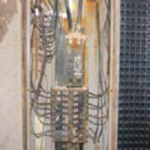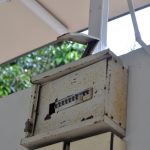| Defects |
Probable causes for the defect |
Design for Maintainability (DfM) Guidelines |
Switchboard / panelboard unsafe
 Water seepage in electrical closet  Unsafe panel board due to damaged/ impaired safety device
|
- Insufficient space or inadequate access for proper operation and maintenance.
- Warning notice / label – not provided, peeled off or not visible.
- Insulation is damaged (crack, blister, warping) by overheating, physical impact or from spillage of cleaning chemicals.
- Moisture ingress in the metal closet or ot is unsuitable for exposure condition.
- Shock hazard
- Swichboard, panelboard: burnt mark or smell
- Rust, dirt causing high resistance and heating at cable contacts.
- Burnt or charred insulation by exposure to external heat source or constant arc produced inside. Inner components should be checked with special means.
|
Design
- Comply with the requirements of electrical installations as per BS 7671:2008+A3:2015, SS CP 5:1998, NFPA 70 [5]; including the location and number of power points.
- Ensure switchboards have adequate space and access for operation and maintenance.
- Specify suitable switch closets with regard to moisture exposure conditions.
- Refer to the definition of types and functionality of RCCBs and specifications for RCBOs as per SS 480:2016 (IEC 61009-1:2010+AMD1:2012+AMD2:2013 CSV BS EN 61009-2-1:1995).
- Provide sub-metering system with remote measurement capability and link to BMS/EMS to track energy consumption data trends [6].
Construction
- Conform to the guidelines for construction and compliance inspection of electrical connections and earthing thereof (BS 1363-4:2016, SS 403:2013).
- Refer to BS 8512:2008 for storage, handling and installation of power cables on wooden drums.
- Install sub-metering system with remote measurement capability and link to BMS/EMS to track energy consumption data trends [6].
- All accessible metal parts of connection units should be in electrical contact with the earthing terminal(s) (BS 1363-4:2016, SS 403:2013).
Maintenance
- Conform to the maintenance of electrical installations as per BS 6423:2014, BS 6626:2010, SS 538: 2008, [3;7].
- Check for insulation damages (e.g. cracks, blisters, warping) caused by overheating, physical impact or by spillage of cleaning chemicals.
- Check for potential short circuits or ground faults. Ensure that switchboards are not exposed to direct sunlight or alternative heat sources.
- Conduct annual shutdown to eradicate hot spots along the distribution network as witnessed by the owner and certified by a Licensed Electrical Worker (LEW).
- Provide necessary warning notices/labels at switchboards (e.g. shock hazard warnings).
|
| Outlet box unsafe

Overloaded plug point, & difficult to access switch
|
- Adapter catering to many devices – poor planning to accommodate future extension.
- Poor design or furniture layout, stacking makes it inaccessible.
|
| Noise / spark |
- Resonant to the magnetic field generated by higher-frequency harmonic current. Use of k-rated transformer is one of the solutions.
|
| No power at receptacle |
- Internal contacts burnt or worn out from constant sparking.
- Careless usage. E.g. forceful insertion of flat pins in round slots.
|
| Jam/ loose switchgear / switch |
- Rough use or vandalism (esp. switches in outlet box).
- Irregular cleaning and lubrication.
- May require replacement after certain time.
- Corrosion from poor make or water seepage in electrical closet.
|
| Inaccurate meter |
- Faulty device needs resetting.
- Broken wires, dirt or dust impeding the movement.
|
References
[1]
Normative References/Standards Referred to for Air Handling Unit and Fan Coil Unit


